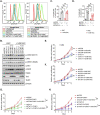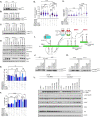This is a preprint.
The thioredoxin system determines CHK1 inhibitor sensitivity via redox-mediated regulation of ribonucleotide reductase activity
- PMID: 37205570
- PMCID: PMC10187419
- DOI: 10.21203/rs.3.rs-2814118/v1
The thioredoxin system determines CHK1 inhibitor sensitivity via redox-mediated regulation of ribonucleotide reductase activity
Update in
-
The thioredoxin system determines CHK1 inhibitor sensitivity via redox-mediated regulation of ribonucleotide reductase activity.Nat Commun. 2024 May 31;15(1):4667. doi: 10.1038/s41467-024-48076-9. Nat Commun. 2024. PMID: 38821952 Free PMC article.
Abstract
Checkpoint kinase 1 (CHK1) is critical for cell survival under replication stress (RS). CHK1 inhibitors (CHK1i's) in combination with chemotherapy have shown promising results in preclinical studies but minimal efficacy with substantial toxicity in clinical trials. To explore novel combinational strategies that can overcome these limitations, we performed an unbiased high-throughput screen in a non-small cell lung cancer (NSCLC) cell line and identified thioredoxin1 (Trx1), a major component of the mammalian antioxidant-system, as a novel determinant of CHK1i sensitivity. We established a role for redox recycling of RRM1, the larger subunit of ribonucleotide reductase (RNR), and a depletion of the deoxynucleotide pool in this Trx1-mediated CHK1i sensitivity. Further, the TrxR1 inhibitor auronafin, an anti-rheumatoid arthritis drug, shows a synergistic interaction with CHK1i via interruption of the deoxynucleotide pool. Together, these findings identify a new pharmacological combination to treat NSCLC that relies on a redox regulatory link between the Trx system and mammalian RNR activity.
Conflict of interest statement
Conflict of interest. Authors declare no competing interest.
Figures









References
Publication types
Grants and funding
LinkOut - more resources
Full Text Sources
Research Materials
Miscellaneous

